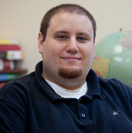 A host of novelists and movie directors have put a kink in the way bioengineers such as Daniel E. Margolis can describe their work to laymen. Co-opted by the science fiction community, the term “artificial intelligence” now carries too much fantastical baggage. Now, “most work in A.I. is called ‘machine learning,’” says Margolis, a doctoral student at Binghamton.
A host of novelists and movie directors have put a kink in the way bioengineers such as Daniel E. Margolis can describe their work to laymen. Co-opted by the science fiction community, the term “artificial intelligence” now carries too much fantastical baggage. Now, “most work in A.I. is called ‘machine learning,’” says Margolis, a doctoral student at Binghamton.
Margolis’ machine learning is in the area of “clinical support systems,” which are computer programs that can learn to make decisions such as diagnosis, prognosis and treatment of medical conditions. “There are various names for these types of computer programs … such as machine learning, data mining or pattern recognition,” says Margolis, who has collaborated with researchers at the H. Lee Moffitt Cancer Center and Research Institute in Tampa, Fla., and at the University of Arizona.
“The work with Moffitt dealt with a newly developed technique that accomplished two difficult tasks: combining the decisions from multiple computer programs intelligently and combining the data from multiple clinical tests intelligently,” Margolis explains. “For example, assume a doctor has several computer programs that try to automatically diagnose lung cancer from a DNA microarray or CT scans. However, each program only works well with certain patients and/or a certain test. This new technique would learn which combination of programs and tests works best for a particular patient.”
The research with Arizona used machine learning to improve methods of evaluating cancer treatment response. “We took the data that is normally used when looking at CT scans, added additional clinical data and then sent it through a machine learning method,” Margolis says. “We showed that machine learning methods could be designed to allow any new type of data to be added, and these methods performed far better than the current ‘gold standard’ method.”
He says they also noticed interesting patterns in “observer variability,” that is, the fact that doctors disagree with each other — and sometimes with themselves. These patterns showed that machine learning methods eventually could be developed to objectively score and train doctors in fields such as radiology.
Margolis says an increase in the use of machines would not affect a patient’s opportunity to receive personalized care. “The goal is for cheaper, better detection methods using computers,” he says. “Nobody would not get the medical test they needed.”
Once he completes his doctorate in systems science, he hopes to work in industrial research. His advisor, Walker Land, predicts success.
“Dan is best described as a unique thinker, one who sees a difficulty as an opportunity rather than a problem,” says Land, research professor of bioengineering. “It’s just the kind of thinking required for successful bioinformatics/biomedical research.”







